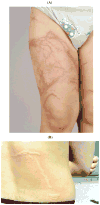Immunological and toxinological responses to jellyfish stings
- PMID: 21824077
- PMCID: PMC3773479
- DOI: 10.2174/187152811797200650
Immunological and toxinological responses to jellyfish stings
Abstract
Just over a century ago, animal responses to injections of jellyfish extracts unveiled the phenomenon of anaphylaxis. Yet, until very recently, understanding of jellyfish sting toxicity has remained limited. Upon contact, jellyfish stinging cells discharge complex venoms, through thousands of barbed tubules, into the skin resulting in painful and, potentially, lethal envenomations. This review examines the immunological and toxinological responses to stings by prominent species of jellyfish including Physalia sp (Portuguese Man-o-War, Blue-bottle), Cubozoan jellyfish including Chironex fleckeri, several Carybdeids including Carybdea arborifera and Alatina moseri, Linuche unguiculta (Thimble jellyfish), a jellyfish responsible for Irukandji syndrome (Carukia barnesi) and Pelagia noctiluca. Jellyfish venoms are composed of potent proteinaceous porins (cellular membrane pore-forming toxins), neurotoxic peptides, bioactive lipids and other small molecules whilst the tubules contain ancient collagens and chitins. We postulate that immunologically, both tubular structural and functional biopolymers as well as venom components can initiate innate, adaptive, as well as immediate and delayed hypersensitivity reactions that may be amenable to topical anti-inflammatory-immunomodifier therapy. The current challenge for immunotoxinologists is to deconstruct the actions of venom components to target therapeutic modalities for sting treatment.
Figures




References
-
- Šuput D. In vivo effects of cnidarian toxins and venoms. Toxicon. 2009;54(8):1190–1200. - PubMed
-
- Zimmer M. GFP: from jellyfish to the Nobel prize and beyond. Chem Soc Rev. 2009;38(10):2823–32. - PubMed
-
- Richet G. La découverte de l’anaphylaxie brève mais triomphale rencontre de deux physiologistes. His Des Sci Méd. 2003;37(4):463–469. - PubMed
-
- Portier MM, Richet C. De l’action anaphylactique de certains venins. Compt Rend Soc Biol (Paris) 1902;54:170–172.
Publication types
MeSH terms
Substances
Grants and funding
LinkOut - more resources
Full Text Sources
Medical
Research Materials

